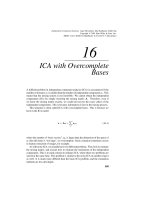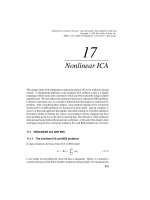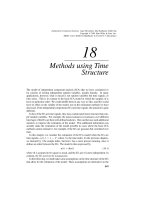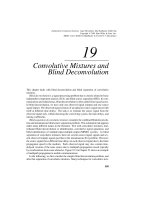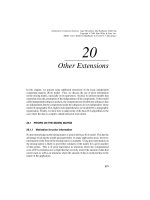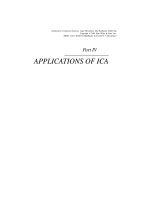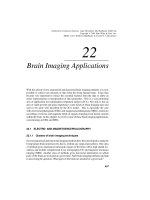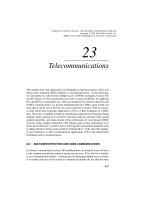Tài liệu Independent Component Analysis - Chapter 23: Telecommunications pptx
Bạn đang xem bản rút gọn của tài liệu. Xem và tải ngay bản đầy đủ của tài liệu tại đây (484.07 KB, 24 trang )
23
Telecommunications
This chapter deals with applications of independent component analysis (ICA) and
blind source separation (BSS) methods to telecommunications. In the following,
we concentrate on code division multiple access (CDMA) techniques, because this
specific branch of telecommunications provides several possibilities for applying
ICA and BSS in a meaningful way. After an introduction to multiuser detection and
CDMA communications, we present mathematically the CDMA signal model and
show that it can be cast in the form of a noisy matrix ICA model. Then we discuss
in more detail three particular applications of ICA or BSS techniques to CDMA
data. These are a simplified complexity minimization approach for estimating fading
channels, blind separation of convolutive mixtures using an extension of the natural
gradient algorithm, and improvement of the performance of conventional CDMA
receivers using complex-valued ICA. The ultimate goal in these applications is to
detect the desired user’s symbols, but for achieving this intermediate quantities such
as fading channel or delays must usually be estimated first. At the end of the chapter,
we give references to other communications applications of ICA and related blind
techniques used in communications.
23.1 MULTIUSER DETECTION AND CDMA COMMUNICATIONS
In wireless communication systems, like mobile phones, an essential issue is division
of the common transmission medium among several users. This calls for a multiple
access communication scheme. A primary goal in designing multiple access systems
is to enable each user of the system to communicate despite the fact that the other
417
Independent Component Analysis. Aapo Hyv
¨
arinen, Juha Karhunen, Erkki Oja
Copyright
2001 John Wiley & Sons, Inc.
ISBNs: 0-471-40540-X (Hardback); 0-471-22131-7 (Electronic)
418
TELECOMMUNICATIONS
FDMA TDMA CDMA
time
code
frequency frequencyfrequency
timetime
codecode
Fig. 23.1
A schematic diagram of the multiple access schemes FDMA, TDMA, and CDMA
[410, 382].
users occupy the same resources, possibly simultaneously. As the number of users in
the system grows, it becomes necessary to use the common resources as efficiently
as possible. These two requirements have given rise to a number of multiple access
schemes.
Figure 23.1 illustrates the most common multiple access schemes [378, 410, 444].
In frequency division multiple access (FDMA), each user is given a nonoverlapping
frequency slot in which one and only one user is allowed to operate. This prevents
interference of other users. In time division multiple access (TDMA) a similar
idea is realized in the time domain, where each user is given a unique time period
(or periods). One user can thus transmit and receive data only during his or her
predetermined time interval while the others are silent at the same time.
In CDMA [287, 378, 410, 444], there is no disjoint division in frequency and time
spaces, but each user occupies the same frequency band simultaneously. The users
are now identified by their codes, which are unique to each user. Roughly speaking,
each user applies his unique code to his information signal (data symbols) before
transmitting it through a common medium. In transmission different users’ signals
become mixed, because the same frequencies are used at the same time. Each user’s
transmitted signal can be identified from the mixture by applying his unique code at
the receiver.
In its simplest form, the code is a pseudorandom sequence of s, also called a
chip sequence or spreading code. In this case we speak about direct sequence (DS)
modulation [378], and call the multiple access method DS-CDMA. In DS-CDMA,
each user’s narrow-band data symbols (information bits) are spread in frequency
before actual transmission via a common medium. The spreading is carried out by
multiplying each user’s data symbols (information bits) by his unique wide-band
chip sequence (spreading code). The chip sequence varies much faster than the
MULTIUSER DETECTION AND CDMA COMMUNICATIONS
419
time
-1
-1
-1
+1
+1
+1
T
T
c
binary data
spreading code
modulated data
time
time
Fig. 23.2
Construction of a CDMA signal [382]. Top: Binary user’s symbols to be trans-
mitted. Middle: User’s specific spreading code (chip sequence). Bottom: Modulated CDMA
signal, obtained by multiplying user’s symbols by the spreading code.
information bit sequence. In the frequency domain, this leads to spreading of the
power spectrum of the transmitted signal. Such spread spectrum techniques are
useful because they make the transmission more robust against disturbances caused
by other signals transmitted simultaneously [444].
Example 23.1 Figure 23.2 shows an example of the formation of a CDMA signal. On
the topmost subfigure, there are 4 user’s symbols (information bits)
to be transmitted.The middle subfigure shows the chip sequence (spreading code).
It is now . Each symbol is multiplied by the chip sequence in a
similar manner. This yields the modulated CDMA signal on the bottom row of Fig.
23.2, which is then transmitted. The bits in the spreading code change in this case 5
times faster that the symbols.
Let us denote the th data symbol (information bit) by , and the chip sequence
by . The time period of the chip sequence is (see Fig. 23.2), so that
when ,and when . The length of the chip
sequence is chips, and the time duration of each chip is = . The number of
bits in the observation interval is denoted by . In Fig. 23.2, the observation interval
contains symbols, and the length of the chip sequence is .
420
TELECOMMUNICATIONS
Using these notations, the CDMA signal at time arising in this simple
example can be written
(23.1)
In the reception of the DS-CDMA signal, the final objective is to estimate the
transmitted symbols. However, both code timing and channel estimation are often
prerequisite tasks. Detection of the desired user’s symbols is in CDMA systems
more complicated than in the simpler TDMA and FDMA systems used previously in
mobile communications. This is because the spreading code sequences of different
users are typically nonorthogonal, and because several users are transmitting their
symbols at the same time using the same frequency band. However, CDMA systems
offer several advantages over more traditional techniques [444, 382]. Their capacity
is larger, and it degrades gradually with increasing number of simultaneous users
who can be asynchronous [444]. CDMA technology is therefore a strong candidate
for future global wireless communications systems. For example, it has already been
chosen as the transmission technique for the European third generation mobile system
UMTS [334, 182], which will provide useful new services, especially multimedia
and high-bit-rate packet data.
In mobile communications systems, the required signal processing differs in the
base station (uplink) from that in the mobile phone (downlink). In the base station,
all the signals sent by different users must be detected, but there is also much more
signal processing capacity available. The codes of all the users are known but
their time delays are unknown. For delay estimation, one can use for example the
simple matched filter [378, 444], subspace approaches [44, 413], or the optimal but
computationally highly demanding maximum likelihood method [378, 444]. When
the delays have been estimated, one can estimate the other parameters such as the
fading process and symbols [444].
In downlink (mobile phone) signal processing, each user knows only its own code,
while the codes of the other users are unknown. There is less processing power than
in the base station. Also the mathematical model of the signals differs slightly, since
users share the same channel in the downlink communications. Especially the first
two features of downlink processing call for new, efficient and simple solutions.
ICA and BSS techniques provide a promising new approach to the downlink signal
processing using short spreading codes and DS-CDMA systems.
Figure 23.3 shows a typical CDMA transmission situation in an urban environ-
ment. Signal 1 arrives directly from the base station to the mobile phone in the car.
It has the smallest time delay and is the strongest signal, because it is not attenuated
by the reflection coefficients of the obstacles in the path. Due to multipath propa-
gation, the user in the car in Fig. 23.3 receives also weaker signals 2 and 3, which
have longer time delays. The existence of multipath propagation allows the signal
to interfere with itself. This phenomenon is known as intersymbol interference (ISI).
Using spreading codes and suitable processing methods, multipath interference can
be mitigated [444].
MULTIUSER DETECTION AND CDMA COMMUNICATIONS
421
Time delay
Magnitude
Fig. 23.3
An example of multipath propagation in urban environment.
There are several other problems that complicate CDMA reception. One of the
most serious ones is multiple access interference (MAI), which arises from the fact
that the same frequency band is occupied simultaneously. MAI can be alleviated by
increasing the length of the spreading code, but at a fixed chip rate, this decreases
the data rate. In addition, the near–far problem arises when signals from near and
far are received at the same time. If the received powers from different users become
too different, a stronger user will seriously interfere with the weaker ones, even if
there is a small correlation between the users’ spreading codes. In the FDMA and
TDMA systems, the near–far problem does not arise because different users have
nonoverlapping frequency or time slots.
The near–far problem in the base station can be mitigated by power control, or by
multiuser detection. Efficient multiuser detection requires knowledge or estimation of
many system parameters such as propagation delay, carrier frequency, and received
power level. This is usually not possible in the downlink. However, then blind
multiuser detection techniques can be applied, provided that the spreading codes are
short enough [382].
Still other problems appearing in CDMA systems are power control, synchroniza-
tion, and fading of channels, which is present in all mobile communications systems.
Fading means variation of the signal power in mobile transmission caused for exam-
ple by buildings and changing terrain. See [378, 444, 382] for more information on
these topics.
422
TELECOMMUNICATIONS
23.2 CDMA SIGNAL MODEL AND ICA
In this section, we represent mathematically the CDMA signal model which is studied
in slightly varying forms in this chapter. This type of models and the formation of
the observed data in them are discussed in detail in [444, 287, 382].
It is straightforward to generalize the simple model (23.1) for
users. The th
symbol of the
th user is denoted by ,and is :th user’s binary chip sequence
(spreading code). For each user , the spreading code is defined quite similarly as in
Example 23.1. The combined signal of simultaneous users then becomes
(23.2)
where
denotes additive noise corrupting the observed signal.
The signal model (23.2) is not yet quite realistic, because it does not take into
account the effect of multipath propagation and fading channels. Including these
factors in (23.2) yields our desired downlink CDMA signal model for the observed
data
at time :
(23.3)
Here the index refers to the symbol, to the user, and to the path. The term
denotes the delay of the th path, which is assumed to be constant during the
observation interval of symbol bits. Each of the simultaneous users has
independent transmission paths. The term is the fading factor of the th path
corresponding to the th symbol.
In general, the fading coefficients are complex-valued. However, we can
apply standard real-valued ICA methods to the data (23.3) by using only the real part
of it. This is the case in the first two approaches to be discussed in the next two
sections, while the last method in Section 23.5 directly uses complex data.
The continuous time data (23.3) is first sampled using the chip rate, so that
equispaced samples per symbol are taken. From subsequent discretized equispaced
data samples , -length data vectors are then collected:
(23.4)
Then the model (23.3) can be written in vector form as [44]
(23.5)
where denotes the noise vector consisting of subsequent last samples of noise
. The vector denotes the “early” part of the code vector, and the “late”
part, respectively. These vectors are given by
(23.6)
CDMA SIGNAL MODEL AND ICA
423
(23.7)
Here is the discretized index representing the time delay, ,
and is a row vector having zeros as its elements. The early and late parts of the
code vector arise because of the time delay , which means that the chip sequence
generally does not coincide with the time interval of a single user’s symbol, but
extends over two subsequent bits and . This effect of the time delay can
be easily observed by shifting the spreading code to the right in Fig. 23.2.
The vector model (23.5) can be expressed in compact form as a matrix model.
Define the data matrix
(23.8)
consisting of
subsequent data vectors .Then can be represented as
(23.9)
where the
matrix contains all the early and late code vectors
(23.10)
and the matrix = contains the symbols and fading terms
(23.11)
The vector represents the symbols and fading terms of all the users and
paths corresponding to the th pair of early and late code vectors.
From the physical situation, it follows that each path and user are at least ap-
proximately independent of each other [382]. Hence every product
or
of a symbol and the respective fading term can be regarded as an independent
source signal. Because each user’s subsequent transmitted symbols are assumed to
be independent, these products are also independent for a given user
. Denote the
independent sources by . Here
every sources correspond to each user, where the coefficient 2 follows from the
presence of the early and late parts.
To see the correspondence of (23.9) to ICA, let us write the noisy linear ICA
model = in the matrix form as
(23.12)
The data matrix has as its columns the data vectors and and
are similarly compiled source and noise matrices whose columns consist of the
source and noise vectors and , respectively. Comparing the matrix CDMA
signal model (23.9) with (23.12) shows that it has the same form as the noisy linear
ICA model. Clearly, in the CDMA model (23.9) is the matrix of source signals,
is the observed data matrix, and is the unknown mixing matrix.
424
TELECOMMUNICATIONS
For estimating the desired user’s parameters and symbols, several techniques are
available [287, 444]. Matched filter (correlator) [378, 444] is the simplest estimator,
but it performs well only if different users’ chip sequences are orthogonal or the users
have equal powers. The matched filter suffers greatly from the near–far problem,
rendering it unsuitable for CDMA reception without a strict power control. The
so-called RAKE detector [378] is a somewhat improved version of the basic matched
filter which takes advantage of multiple propagation paths. The maximum likelihood
(ML) method [378, 444] would be optimal, but it has a very high computational load,
and requires knowledge of all the users’ codes. However, in downlink reception,
only the desired user’s code is known. To remedy this problem while preserving
acceptable performance, subspace approaches have been proposed for example in
[44]. But they are sensitive to noise, and fail when the signal subspace dimension
exceeds the processing gain. This easily occurs even with moderate system load
due to the multipath propagation. Some other semiblind methods proposed for the
CDMA problem such as the minimum mean-square estimator (MMSE) are discussed
later in this chapter and in [287, 382, 444].
It should be noted that the CDMA estimation problem is not completely blind,
because there is some prior information available. In particular, the transmitted
symbols are binary (more generally from a finite alphabet), and the spreading code
(chip sequence) is known. On the other hand, multipath propagation, possibly fading
channels, and time delays make separation of the desired user’s symbols a very
challenging estimation problem which is more complicated than the standard ICA
problem.
23.3 ESTIMATING FADING CHANNELS
23.3.1 Minimization of complexity
Pajunen [342] has recently introduced a complexity minimization approach as a true
generalization of standard ICA. In his method, temporal information contained in
the source signals is also taken into account in addition to the spatial independence
utilized by standard ICA. The goal is to optimally exploit all the available information
in blind source separation. In the special case where the sources are temporally white
(uncorrelated), complexity minimization reduces to standard ICA [342]. Complexity
minimization has been discussed in more detail in Section 18.3.
Regrettably, the original method for minimizing the Kolmogoroffcomplexity mea-
sure is computationally highly demanding except for small scale problems. But if the
source signals are assumed to be gaussian and nonwhite with significant time correla-
tions, the minimization task becomes much simpler [344]. Complexity minimization
then reduces to principal component analysis of temporal correlation matrices. This
method is actually just another example of blind source separation approaches based
on second-order temporal statistics; for example [424, 43], which were discussed
earlier in Chapter 18.
ESTIMATING FADING CHANNELS
425
In the following, we apply this simplified method to the estimation of the fad-
ing channel coefficients of the desired user in a CDMA systems. Simulations with
downlink data, propagated through a Rayleigh fading channel, show noticeable per-
formance gains compared with blind minimum mean-square error channel estimation,
which is currently a standard method for solving this problem. The material in this
section is based on the original paper [98].
We thus assume that the fading process is gaussian and complex-valued. Then the
amplitude of the fading process is Rayleigh distributed; this case is called Rayleigh
fading (see [444, 378]). We also assume that a training sequence or a preamble is
available for the desired user, although this may not always be the case in practice.
Under these conditions, only the desired user’s contribution in the sampled data is
time correlated, which is then utilized. The proposed method has the advantage that
it estimates code timing only implicitly, and hence it does not degrade the accuracy
of channel estimation.
A standard method for separating the unknown source signals is based on mini-
mization of the mutual information (see Chapter 10 and [197, 344]) of the separated
signals
= = :
(23.13)
where is the entropy of (see Chapter 5). But entropy has the interpretation
that it represents the optimum averaged code length of a random variable. Hence
mutual information can be expressed by using algorithmic complexity as [344]
(23.14)
where is the per-symbol Kolmogoroff complexity, given by the number of bits
needed to describe . By using prior information about the signals, the coding costs
can be explicitly approximated. For instance, if the signals are gaussian, indepen-
dence becomes equivalent to uncorrelatedness. Then the Kolmogoroff complexity
can be replaced by the per-symbol differential entropy, which in this case depends on
second-order statistics only.
For Rayleigh type fading transmission channels, the prior information can be for-
mulated by considering that the probability distributions of the mutually independent
source signals have zero-mean gaussian distributions. Suppose we want to
estimate the channel coefficients of the transmission paths, by sending a given length
constant symbol sequence to the desired user. We consider the signals
, , with representing the indexes of the sources correspond-
ing to the first user. Then will actually represent the channel coefficients of all
the first user’s paths. Since we assume that the channel is Rayleigh fading, then these
signals are gaussian and time correlated. In this case, blind separation of the sources
can be achieved by using only second-order statistics. In fact, we can express the
Kolmogoroff complexity by coding these signals using principal component analysis
[344].
426
TELECOMMUNICATIONS
23.3.2 Channel estimation *
Let = denote the vector consisting of last
samples of every such source signal , . Here is the number of
delayed terms, showing what is the range of time correlations taken into account when
estimating the current symbol. The information contained in any of these sources can
be approximated by the code length needed for representing the principal com-
ponents, which have variances given by the eigenvalues of the temporal correlation
matrix =E [344]. Since we assume that the transmission paths are
mutually independent, the overall entropy of the source is given by summing up the
entropies of the principal components. Using the result that the entropy of a gaussian
random variable is given by the logarithm of the variance, we get for the entropy of
each source signal
(23.15)
Inserting this into the cost function (23.13) yields
(23.16)
where is the separating matrix.
The separating matrix can be estimated by using a gradient descent approach
for minimizing the cost function (23.16), leading to the update rule [344]
(23.17)
where is the learning rate and is the momentum term [172] that can be introduced
to avoid getting trapped into a local minimum corresponding to a secondary path.
Let denote the th row vector of the separating matrix . Since only the
correlation matrix of the th source depends on , we can express the gradient
of the cost function by computing the partial derivatives
with respect to the scalar elements of the vector = . For these
partial derivatives, one can derive the formula [344]
trace E (23.18)
Since = ,weget
(23.19)
ESTIMATING FADING CHANNELS
427
where is the element of the observation matrix defined earlier using
formulas (23.4) and (23.9).
What is left to do now is to compute the gradient update part due to the mapping
information. It can be written [344]
(23.20)
where is a projection matrix onto the subspace spanned
by the column vectors of the matrix = . Now the cost function
can be separated, and the different independent components can be found one by
one, by taking into account the previously estimated components, contained in the
subspace spanned by the columns of the matrix .
Since our principal interest lies in the transmission path having the largest power,
corresponding usually to the desired user, it is sufficient to estimate the first such
independent component. In this case, the projection matrix becomes a zero
matrix. Then the overall gradient (23.17) for the first row of the separating
matrix can be written
trace E
(23.21)
It suffices to consider the special case where only the two last samples are taken
into account, so that the the delay . First, second-order correlations are re-
moved from the data by whitening. This can be done easily in terms of standard
principal component analysis as explained in Chapter 6. After whitening, the subse-
quent separating matrix will be orthogonal, and thus the second term in Eq. (23.16)
disappears, yielding the cost function
(23.22)
with the autocorrelation matrices given by
E
E
(23.23)
In this case, the separating vectors can be found by maximizing sequentially
E , which is the first-order correlation coefficient
of . It follows that the function to be maximized becomes
E (23.24)
So the separating vector corresponding to the most important path is given by
the principal eigenvector of the matrix in Eq. (23.24). We have used a symmetric
expression for the correlation coefficients in order to avoid asymmetry when the
428
TELECOMMUNICATIONS
0 100 200 300 400 500 600 700 800 900 1000
−2
−1
0
1
2
0 100 200 300 400 500 600 700 800 900 1000
−4
−2
0
2
4
0 100 200 300 400 500 600 700 800 900 1000
−5
0
5
Fig. 23.4
The original fading process (top), its estimate given by our method (middle), and
estimate given by the blind MMSE method (bottom). The signal-to-noise ratio was
dB.
observed data set is finite. This usually improves the estimation accuracy. Finally,
we separate the desired channel coefficients by computing the quantities
(23.25)
where denotes whitened data vector . This is done for all the data vectors
contained in (23.8).
23.3.3 Comparisons and discussion
We have compared the method described and derived above to a well-performing
standard method used in multiuser detection, namely the minimum mean-square
error estimator [452, 287]. In the MMSE method, the desired signal is estimated
(up to a scaling) from the formula
(23.26)
where and are the matrices containing (in the same order) the eigenvalues and
the respective eigenvectors of the data correlation matrix . The vector is
a column of the matrix defined in (23.10) corresponding to the desired user’s bit
, that is, either or . The quantity is again computed for all the
data vectors . If the pilot signal consists of ones, then provides
estimates of the channel coefficients.
ESTIMATING FADING CHANNELS
429
10 12 14 16 18 20 22 24 26 28 30
0
0.05
0.1
0.15
0.2
0.25
SNR
MSE
MMSE
blind
estimation
Fig. 23.5
The mean-square errors of the MMSE method and our method as the function of
the signal-to-noise ratio. The number of users was
.
The algorithms were tested in a simulation using length quasiorthogonal
gold codes (see [378]). The number of users was , and the number of
transmission paths was . The powers of the channel paths were , ,and
dB respectively for every user, and the signal-to-noise ratio (SNR) varied from 30
dB to 10 dB with respect to the main path. Only the real part of the data was used.
The observation interval was symbols long.
We compared our algorithm with the blind MMSE method, where the pilot signal
corresponding to the first user consisted of ones. The fading coefficients correspond-
ing to the strongest path were estimated using both methods. Fig. 23.4 shows the
original fading process and the estimated ones, giving an idea of the achieved accu-
racy. The figure shows that our method provides somewhat more accurate estimates
than the MMSE method, though the estimated fading process is noisy. Fig. 23.5
presents numerical values of the average mean-square error (MSE) as a function
of SNR. The complexity minimization based method performs clearly better than
the MMSE method especially at lower signal-to-noise ratios. The convergence of
the gradient approach took place in this case in 10–15 iterations for the learning
parameters and .
In its current form, the proposed method needs training symbols for providing a
temporally correlated structure for the desired user’s signal. If the channel varies
rapidly during the training phase, the method is not able to estimate the channel as
the data modulation is on. This is because the temporal correlatedness of the desired
430
TELECOMMUNICATIONS
signal is lost. A future research topic is to overcome this problem. Finally, we point
out that instead of the simplified complexity minimization approach applied here, one
could have as well tried other blind separation methods based on the time structure
of the sources. Such methods are discussed in Chapter 18.
23.4 BLIND SEPARATION OF CONVOLVED CDMA MIXTURES *
Now consider estimation of the desired user’s symbol process using a blind source
separation method developed for convolutive mixtures. Such methods have been
discussed earlier in Chapter 19. The model consists of a linear transformation of
both the independent variables (the transmitted symbols) and their delayed version,
where the delay is one time unit. For separating mixtures of delayed and convolved
independent sources, we use an extension of the natural gradient method based on
the information maximization principle [79, 13, 268, 426]. Experiments show that
the proposed method has quite competitive detection capabilities compared with
conventional symbol estimation methods.
23.4.1 Feedbac k architecture
The vector model (23.5) can be written
(23.27)
This model differs slightly from the fading channel model used in the previous section
in that the channel is now assumed to stay constant during the block of symbols.
Hence, the fading coefficients depend only on the path but not on the symbol
index . This type of channel is called block fading. As in the previous section, we
use only the real part of the complex-valued data. This allows application of ICA
and BSS methods developed for real-valued data to CDMA.
The model (23.27) can be further expressed in the matrix-vector form [99]
(23.28)
where and are mixing matrices corresponding to the original and the
one time unit delayed symbols. The column vectors of and are given by the
early and the late parts of the coding vectors multiplied by the fading coefficients,
respectively:
(23.29)
(23.30)
BLIND SEPARATION OF CONVOLVED CDMA MIXTURES *
431
The symbol vector contains the binary symbols (information bits) of the users
at time index :
(23.31)
The vector is defined quite similarly.
Eq. (23.28) shows that our CDMA signal model represents a linear mixture of
delayed and convolved sources in the special case where the maximum time delay is
one unit. Assuming that all the mixing matrices (users’ codes) and symbol sequences
are unknown makes the separation problem blind. One method for solving this
convolutive BSS problem is to consider a feedback architecture. Assuming that the
users are independent of each other, we can apply to the convolutive BSS problem
the principle of entropy maximization discussed earlier in Section 9.3. The weights
of the network can be optimized using the natural gradient algorithm extended for
convolutive mixtures in [13, 79, 268, 426].
The data vectors are preprocessed by simultaneously whitening them and
reducing their dimension to (the number of users). Using PCA whitening (Chapter
6), the whitened data matrix becomes
(23.32)
We can now write the whitened version of Eq. (23.28)
(23.33)
where is the whitened input vector, and and are whitened square
matrices corresponding to the rectangular matrices and . From (23.33), the
symbol vector can be expressed in terms of the whitened data vector and the
previously estimated symbol vector as
(23.34)
The arising network architecture is depicted in Fig. 23.6.
23.4.2 Semiblind separation method
Based on this feedback architecture we propose the following algorithm for blind
symbol detection in a CDMA system.
1. Initialize randomly the matrices and .
2. Compute updates for the matrices and from the formulas [79, 268, 426]
(23.35)
(23.36)
Here is a unit matrix, and = is a nonlinearly transformed
symbol vector . The nonlinear function is typically a sigmoidal or cubic
nonlinearity, and it is applied componentwise to the elements of .
432
TELECOMMUNICATIONS
H
H
b
vr
Whitening
0
m
mm
-1
z
-1
1
-
+
Fig. 23.6
A feedback network for a convolutive CDMA signal model
3. Compute new estimates for the matrices and using the rule
(23.37)
where is a small learning parameter.
4. Compute new estimate of the symbol vector from Eq. (23.34).
5. If the matrices and have not converged, return back to step 2.
6. Apply the sign nonlinearity to each component of the final estimate of the
symbol vector . This quantizes the estimated symbols to the bits or .
7. Identify the desired user’s symbol sequence which best fits the training se-
quence.
If some prior information on the desired user’s transmission delays is available,
it can be utilized in the initialization step 1. The update rules in step 2 have been
adapted for our special case of only one unit delay from the more general convolutive
mixture algorithms described in [268, 426]. Because of the feedback, the choice of
the learning parameter in step 3 is essential for the convergence. We have used
a constant , but more sophisticated iteration dependent choices would probably
make the convergence faster. In step 5, convergence is verified in terms of the mean-
square-error matrix norm. Since the transmission system is binary differential, step
6 provides the most probable value for the estimated symbol. The detector estimates
the symbols of all users up to a permutation. Therefore a pilot training sequence is
needed in step 7 to identify the desired user. Hence the method presented above is
an example of a semiblind separation approach.
23.4.3 Simulations and discussion
The method introduced in the previous section has been compared in [99] with two
standard methods used in multiuser detection, namely the matched filter (MF) and the
BLIND SEPARATION OF CONVOLVED CDMA MIXTURES *
433
minimum mean-square error (MMSE) estimator [378, 444, 382, 287]. The matched
filter estimator is simply
sign (23.38)
which is again computed for all the data vectors
. Here is a column
of the matrix
defined in (23.29) that corresponds to the desired user’s bit .
Similarly, the (linear) MMSE symbol estimator is given by
sign (23.39)
The matrices
, were defined earlier below Eq. (23.26).
It is noteworthy that the formula (23.39) is otherwise the same as (23.26), but
now it provides bit estimates instead of fading channel coefficient estimates
. The reason for this is that in the previous section the quantities to be
estimated were products of bits and fading channel coefficients, or elements of the
vector defined in (23.11), and the bits were all ones in the pilot training sequence.
On the other hand, in this section the vector also contains the fading coefficients
(which stay constant during the observation interval) because of the definition of
the matrix in (23.29).
The algorithms were tested using quasiorthogonal gold codes [378] of length
. The number of users was either or , and the number of
transmission paths was . The powers of the channel paths were, respectively,
and dB for every user, and the signal-to-noise ratio (SNR) varied from
dB to dB with respect to the main path. Only the real part of the data was used.
The observation interval was . A pilot training sequence of length
was compared with the preambles of the separated sources for identifying the desired
user. A constant learning parameter was used. Convergence took about
iterations in the above environment.
The experimental results shown in Fig. 23.7 give the bit-error-rates (BERs) for
the compared three methods at different SNRs in the more difficult case of
users. The results are qualitatively similar for users [99], and are therefore not
shown here. Figure 23.7 indicates that the proposed semiblind convolutive separation
method yields clearly better detection results than the widely used matched filter or
linear minimum mean-square error estimators. The basic reason for this improved
performance is that standard methods such as the MF and MMSE estimators do not
exploit the independence of the received signals. The MMSE estimator makes the
detected sources uncorrelated [287]. Even this much weaker assumption improves
the performance clearly compared with the simple matched filter. In the studied
scenario the independence of the received signals is a reasonable assumption, and its
power becomes apparent by inspecting the results in Fig. 23.7.
We have in this section considered a batch method based on a feedback architec-
ture for symbol detection, but an adaptive version could have been used instead. The
batch method has the advantage that two observation vectors are used for estimating
the current symbol vector, which improves the estimation. There is also no need for
synchronization as is the case with the MMSE and MF methods. This is because dif-
434
TELECOMMUNICATIONS
0 5 10 15 20 25 30
0
0.05
0.1
0.15
0.2
0.25
SNR (dB)
BER (%)
MF
MMSE
conv. ICA
Fig. 23.7
The bit-error-rate (BER) for the convolutive mixture ICA, minimum mean-square
error (MMSE), and matched filter (MF) methods. The number of users was
.
ferent users’ path delays are implicitly estimated simultaneously in the basis vectors
of the mixing matrices.
23.5 IMPROVING MULTIUSER DETECTION USING COMPLEX ICA *
A general drawback of ICA methods in CDMA applications is that it is difficult or even
impossible to utilize well the available prior information on the problem. However,
quite generally in any problem it is highly desirable to apply prior information
whenever available, because it usually improves estimation accuracy and overall
performance if taken into account properly. In this section, a feasible solution to
this issue is presented by using ICA as an additional processing element attached to
existing standard receiver structures.
In this section, two types of receiver structures, RAKE-ICA and MMSE-ICA
[382], are studied in a block fading CDMA downlink environment. Numerical
results indicate that the performance of RAKE and subspace MMSE detectors can
be greatly improved in terms of ICA postprocessing. This is mainly due to the facts
IMPROVING MULTIUSER DETECTION USING COMPLEX ICA *
435
that ICA efficiently utilizes the independence of the original signals, and that ICA
does not explicitly depend on erroneous timing or channel estimation. On the other
hand, the RAKE and subspace MMSE estimators can apply prior information on the
CDMA problem. Since these estimators are complex-valued, an ICA method fitted
to complex data must be used. To this end, complex FastICA algorithm (see Section
20.3 and [47]) is used.
This section is based on the references [382, 383]. The interested reader can find
more information on ICA assisted CDMA reception in them.
23.5.1 Data model
The continuous time signal model is otherwise the same as in (23.3), but the fading
coefficients in (23.3) are now replaced by the complex coefficients . Thus
each path has its own coefficient which is assumed to remain constant during
the data block of symbols , . Another difference is that the
processing window is now two symbols long while its length in the previous sections
is one symbol. Hence the samples are collected into -dimensional vectors
(23.40)
instead of the -dimensional data vectors (23.4).
Since sampling is asynchronous with respect to the symbols, the vector sample
in (23.40) usually contains information on three successive symbols , ,
and . The two symbols long data window has the advantage that it always
contains one complete symbol. Similarly as in (23.27), the vectors (23.40) can be
expressed in the well-known form
(23.41)
The “early” and “late” code vectors and are defined quite similarly as in Eqs.
(23.6) and (23.7). Now they just contain more zeros so that these vectors become -
dimensional. However, the late code vector is now associated with the symbol
, and for the middle symbol the “middle” code vectors
(23.42)
are defined, where is a row vector having zeros as its elements.
Again, the data vectors (23.41) can be represented more compactly as
(23.43)
which has the form of a noisy linear ICA model. The dimensional code
matrix corresponds to the mixing matrix . It is assumed to have full rank, and
436
TELECOMMUNICATIONS
contains the code vectors and path strengths:
(23.44)
The -dimensional symbol vector
(23.45)
contains the symbols, and corresponds to the vector
of independent (or roughly
independent) sources. Note that both the code matrix and the symbol vector
consists of subsequent triplets corresponding to the early, middle, and late parts.
23.5.2 ICA based receivers
In the following, we consider in more detail two ways of initializing the ICA iteration.
For a more thorough discussion, see [382]. The starting point for the receiver
development is to look at the noiseless whitened data
1
(23.46)
where and are matrices containing (in the same order) the principal
eigenvalues and -vectors of the data autocorrelation matrix E , respectively.
It is easy to see that for the data model (23.43), the whitening matrix becomes
orthonormal: = , because the symbols are uncorrelated: E = ,and
the whitened data vectors satisfy the condition =E .
It suffices to estimate one column of the whitening matrix , say its second
column . This is because we can then estimate the symbols of the desired user
(user ) by applying the vector as follows:
(23.47)
From the definitions of and we see that
(23.48)
which is exactly the subspace MMSE detector [451] for dispersive channels.
1
Because the data is now complex-valued, the transpose must be replaced by the Hermitian operator
, which equals transposition and complex conjugation.
IMPROVING MULTIUSER DETECTION USING COMPLEX ICA *
437
Equation (23.48) can be applied to separating the desired symbol ,butit
uses only second-order statistics. In addition, the subspace parameters as well as
the path gains and delays are always subject to estimation errors, degrading the
performance of (23.48) in separation. But we can improve the separation capability
of the estimator (23.48) by using ICA as a postprocessing tool. This is possible,
since the independence of the original sources is not utilized in deriving (23.48).
Moreover, it is meaningful to apply ICA by using the subspace MMSE estimator
(23.48) as the starting point, because it already identifies the desired user. This
identification is not possible by using ICA alone. The proposed DS-CDMA receiver
structure, which we call MMSE-ICA, consists of a subspace MMSE detector refined
by ICA iterations. The complex FastICA algorithm discussed earlier in Section
20.3 and in [47] is a natural choice for the ICA postprocessing method. It can deal
with complex-valued data, and extracts one independent component at a time, which
suffices in this application.
Alternatively, known or estimated symbols can be used for initializing the ICA
iteration. This follows from the uncorrelatedness of the symbols, since then we
have E
= , leading again to the subspace MMSE detector. Because
training symbols are not necessarily implemented in all the DS-CDMA systems, it is
preferable to first use the traditional RAKE receiver [378, 382] or multipath correlator
for detecting symbols. The RAKE estimator is nothing but a simple extension of the
matched filter for several paths. Alternatively, one can initially detect the symbols by
using the MMSE method for symbol outputs. The symbol estimates obtained initially
in terms of the RAKE detector or MMSE symbol estimator are then refined using
the complex FastICA algorithm. These structures are henceforth called as RAKE-
ICA and MMSEbit-ICA detectors, respectively. Global convergence of the complex
FastICA algorithm has been proved in [382]. The sign indeterminacy in the sources
estimated by any ICA method is removed by a comparator element, which chooses
the sign according to the RAKE receiver or subspace MMSE detector, respectively.
The proposed receiver structures are summarizes below. In step 1, an initial
estimate of the
th whitened code vector is computed using one of the three
standard detection methods mentioned earlier. Steps 2-5 give the procedure for
improving this initial estimate using the complex FastICA algorithm [47].
ICA-based blind interference suppression schemes
[382] Let be the
index of the desired user, and the whitened data vector corresponding to the
symbol vector . The constant is for complex-valued symbols, and for
real-valued symbols (in the latter case, the data itself is complex, but the symbols
are real). An estimate is denoted by the hat . Then the iterative algorithms for blind
interference suppression are as follows.
1. Initialize = ,where
(a) MMSE-ICA: = .
(b) RAKE-ICA: =E .
(c) MMSEbit-ICA: =E .
438
TELECOMMUNICATIONS
Let .
2. Compute one iteration of the complex FastICA algorithm [47]:
E
(23.49)
3. Divide
by its norm.
4. If is not close enough to ,set , and go back to step
2.
5. Output the vector = ,where =sign .
23.5.3 Simulation results
The algorithms were tested using simulated DS-CDMA downlink data with a block
fading channel.
In the first experiment gold codes of the length were used. The length
of the block was binary phase shift keying (BPSK) symbols. The channel
was fixed during the block period. The number of users was ,andthe
multiple access interference (MAI) per user was dB. Hence, the total interference
power was dB. The number of paths was . The path gains were gaussian
distributed with a zero mean, and the path delays were chosen randomly from the
interval . The delays and the path gains were assumed to
be known. The signal-to-noise ratio (in the chip matched filter output) varied with
respect to the desired user from dB to dB, and 10000 independent trials were
made. A constant was used in the ICA iteration.
Figure 23.8 shows the achieved bit-error-rates (BERs) for the methods as a function
of the SNR. The performance of RAKE is quite modest due to the near–far situation.
Consequently, RAKE-ICA is able to improve the performance of the RAKE method
only marginally. Subspace MMSE detector suffers from interference floor at higher
SNRs. One reason for this is inaccurate estimation of the signal subspace. Even
though MMSE-ICA uses the same estimate for the signal subspace, it is able to
exploit the statistical independence of the source signals, and seems to follow quite
closely the equal length optimal MMSE receiver, denoted as MMSE bound.
Figure 23.9 shows the corresponding block-error-rates (BLER) for these methods.
A block is correctly estimated if all the symbols in the block are estimated correctly.
For speech and data services that do not require real-time processing, raw BLER of
is sufficient. For real-time data services, raw BLER of the order of is
required. Figure 23.9 shows that RAKE-ICA actually improves the performance of
the RAKE method quite remarkably with respect to BLER, even though the overall
BER has not been improved that much.
More numerical experiments, including simulation results for the case of purely
complex data ( ), can be found in [382, 383]. They clearly indicate that the
estimates given by the RAKE and subspace MMSE detectors can be greatly improved
by using ICA as a postprocessing tool.
CONCLUDING REMARKS AND REFERENCES
439
5 10 15 20 25 30 35
10
−7
10
−6
10
−5
10
−4
10
−3
10
−2
10
−1
10
0
RAKE
RAKE−ICA
subspace MMSE
MMSE−ICA
MMSE bound
Fig. 23.8
Bit-error-rate as a function of SNR ( dB). The system includes
users with the average MAI of dB per interfering user. BPSK data is used.
23.6 CONCLUDING REMARKS AND REFERENCES
In this chapter, we have applied several quite different extensions of basic ICA (or
BSS) techniques to short-code CDMA data. It can be concluded that ICA often
provides significant performance gains in CDMA applications. Basically, this results
from the fact that standard CDMA detection and estimation methods do not exploit
the powerful but realistic independence assumption. At best, they utilize the much
weaker uncorrelatedness condition for the received source signals.
CDMA techniques are currently studied extensively in telecommunications, be-
cause they will be used in a form or another in future high performance mobile
communications systems. A specific feature of all telecommunications applications
of ICA is that they are almost always semiblind problems. The receiver has more or
less prior information on the communication system, typically at least the spreading
code of the desired user is known. This prior information should be combined in
a suitable way with blind ICA techniques for achieving optimal results. Another
important design feature is that practical algorithms should not be computationally
too demanding, making it possible to realize them in real time.
440
TELECOMMUNICATIONS
5 10 15 20 25 30 35
10
−4
10
−3
10
−2
10
−1
10
0
RAKE
RAKE−ICA
subspace MMSE
MMSE−ICA
MMSE bound
Fig. 23.9
Block-error-rate as afunction of SNR ( dB). The system includes
users with the average MAI of dB per interfering user. BPSK data is used.
ICA methods also have been applied to CDMA data, for example, in references
[223, 384, 100]. Other applications of blind source separation techniques to various
communications problems can be found for example in [77, 111, 130, 435]. Related
blind identification or blind equalization techniques are discussed in many papers;
see for example [41, 73, 91, 122, 146, 143, 144, 158, 184, 224, 265, 276, 287, 351,
352, 361, 425, 428, 431, 439, 440] and the references therein. Blind identification
techniques used in communications typically exploit second-order temporal statistics
(or suitable explicit higher-order statistics) instead of ICA. The interested reader can
find many more references on blind communications techniques in recent confer-
ence proceedings and journals dealing with telecommunications and statistical signal
processing.

